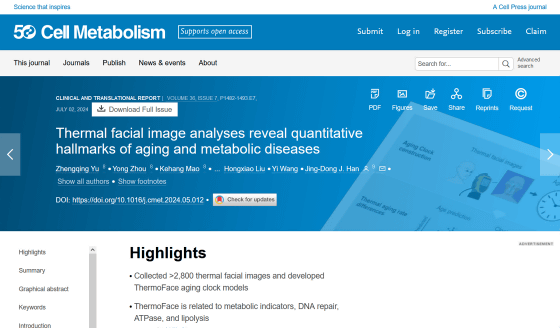Research results show that 'facial heat maps' can predict age and illness

Signs of human aging and disease appear in various parts of the body, and by reading these signs, it is possible to diagnose illnesses and health conditions. A new Chinese research team has announced the results of a study that shows that a person's aging and disease can be predicted by examining their 'face heat map.'
Thermal facial image analyses reveal quantitative hallmarks of aging and metabolic diseases: Cell Metabolism
https://www.cell.com/cell-metabolism/fulltext/S1550-4131(24)00188-8

Doctors could soon use facial temperature for | EurekAlert!
https://www.eurekalert.org/news-releases/1049756
Your Face's Heat Patterns Could Reveal Vital Clues About Your Health: ScienceAlert
https://www.sciencealert.com/your-faces-heat-patterns-could-reveal-vital-clues-about-your-health
Professor Jindong Han and his team at the Center for Quantitative Biology at Peking University had previously conducted research into predicting biological age using the 3D structure of a person's face. After that, Han and his team began a new study, wondering if they could use 'human facial temperature' to predict aging and health.
The researchers recruited 2,811 Chinese adults aged between 21 and 88 years old and measured their facial temperatures in a temperature-controlled room. They then trained an AI model that could use the facial temperature data to predict age, to see if there were any thermal patterns that could predict age.
As a result, it was found that temperature changes in areas such as the nose and eyes are related to a person's age. The figure below shows the face heatmaps of a woman on the left and a man on the right, arranged from top to bottom in the order of '50-60 years old,' '60-70 years old,' and '70 years old and over.' Furthermore, each age is classified as 'Slow-ager,' 'Well predicted,' and 'Fast-ager,' but overall there is a tendency that 'the temperature of the nose decreases with age' and 'the temperature around the eyes increases with age.'

The team also investigated whether the subjects' facial temperatures were related to certain diseases, finding that the predicted age of people with diabetes was more than six years older than that of healthy subjects of the same age.
By analyzing the facial temperature data, the AI model was able to predict with over 80% accuracy whether the subject had a metabolic disorder such as fatty liver disease or diabetes. People with metabolic disorders tend to have higher temperatures around the eyes, while people with high blood pressure tend to have higher temperatures around the eyes and cheeks, and relatively lower temperatures around the nose.

To investigate why facial temperature changes with age, the team analyzed blood and facial temperature data from 57 healthy subjects and found that elevated temperatures around the eyes and cheeks were associated with increased cellular activity related to inflammation.
In addition, to investigate whether exercise affects facial temperature, 23 subjects were asked to jump rope at least 800 times a day for two weeks, and facial temperature data was compared before and after the experiment. Surprisingly, after just two weeks of exercise, the subjects' predicted ages based on facial temperature data were five years younger. On the other hand, there was no significant difference in predicted ages after two weeks in the control group, who did not jump rope.
'The temperature clock was very strongly associated with metabolic diseases, but previous facial imaging models were unable to predict these diseases,' said Han. 'Facial temperature imaging may be useful for early diagnosis and early intervention of diseases, so we hope to apply this in clinical settings.'
Related Posts:
in Science, Posted by log1h_ik







